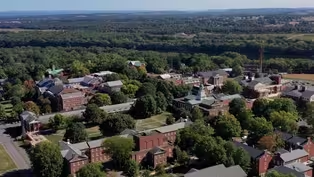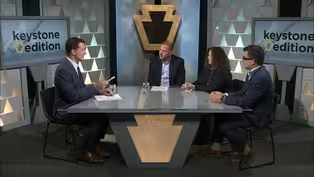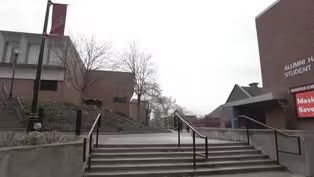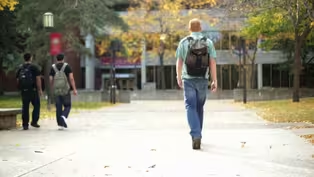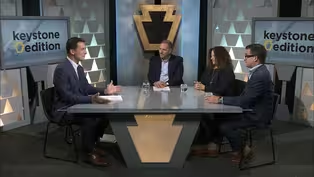Keystone Edition
Education on the Edge
10/14/2024 | 26m 59sVideo has Closed Captions
What's causing this drop in enrollment, and is there any way to recover?
A higher education enrollment cliff has been on the horizon for years. For some schools, it's already here. They've been forced into consolidation or closure. But what's causing this drop in enrollment, and is there any way to recover? We explore what it all means in Keystone Edition Business: Education on the Edge.
Problems playing video? | Closed Captioning Feedback
Problems playing video? | Closed Captioning Feedback
Keystone Edition is a local public television program presented by WVIA
Keystone Edition
Education on the Edge
10/14/2024 | 26m 59sVideo has Closed Captions
A higher education enrollment cliff has been on the horizon for years. For some schools, it's already here. They've been forced into consolidation or closure. But what's causing this drop in enrollment, and is there any way to recover? We explore what it all means in Keystone Edition Business: Education on the Edge.
Problems playing video? | Closed Captioning Feedback
How to Watch Keystone Edition
Keystone Edition is available to stream on pbs.org and the free PBS App, available on iPhone, Apple TV, Android TV, Android smartphones, Amazon Fire TV, Amazon Fire Tablet, Roku, Samsung Smart TV, and Vizio.
Providing Support for PBS.org
Learn Moreabout PBS online sponsorship- [Announcer] Live from your Public Media Studios, WVIA Presents "Keystone Edition Business," a public affairs program that goes beyond the headlines to address issues in Northeastern and Central Pennsylvania.
This is "Keystone Edition Business."
And now, moderator Steve Stumbris.
- Hi, I'm Steve Stumbris.
Traditional institutions of higher education, like four year colleges and universities, are facing an emergent situation.
Over the next two years, there will be an expected drop in college aged students entering those schools.
The question is, why is it happening, and what are the future impacts including on the economies of communities and regions around these schools?
These are the things we are here to answer starting with WVIA news reporter, Sarah Scinto.
(air whooshes) - [Sarah] Traditional four year colleges and universities are facing a crisis.
Experts predict a sharp decline in the number of students advancing to higher education.
This drop could start as soon as next year, but some schools in Northeastern Pennsylvania are already feeling the effects.
After a decade of declining enrollment, Clarks Summit University closed its doors this year before the fall semester.
Penn State, the largest university in the state, has not been immune to enrollment challenges either.
The university went through workforce reduction this year across its 20 campuses to mitigate some of its financial losses.
So why are schools of all sizes getting ready for a drastic drop?
Mostly demographics and cost.
The 2008 recession brought a significant drop in birth rates.
So there are fewer potential students graduating from high school.
And as costs increase everywhere, fewer people are willing to take on a large amount of student debt that could take decades to repay.
In Northeastern and Central Pennsylvania, many learners are looking for alternatives to traditional four year colleges and universities where they can spend less time and money in school and enter the workforce faster.
Luzerne County Community College in Nanticoke, Pennsylvania College of Technology in Williamsport, and Johnson College in Scranton are all seeing increases in enrollment.
Johnson College is reporting record high enrollment for the sixth year in a row.
Pennsylvania College of Technology had its largest enrollment increase since 2008.
And LCCC started the fall semester up 7%.
For more coverage on the enrollment cliff and enrollment numbers for other schools in Northeast Pennsylvania, go to wvia.org.
For "Keystone Edition Business," I'm Sarah Scinto, WVIA News.
- I'd like to introduce our panelists here to share their perspectives.
First, we have Larry Newman joining us from the Diamond City Partnership in Downtown Wilkes-Barre.
Teri Ooms is here from the Institute for Public Policy and Economic Development, and Dan Knorr is the Executive Director for Economic Development and External Affairs for Commonwealth University.
Thank you for joining us.
If you have questions, you can ask at keystone@wvia.org.
Now to our panelists.
Larry, Teri, Dan, thank you much for joining us for this important conversation.
I value each of the perspectives and expertise you bring from your roles.
Teri, I'd like to start with you.
In hearing the numbers that Sarah presented, what is your broader perspective from the research that the institute does?
How is that impacting universities in our region?
What are these universities doing to prepare for this situation that's already starting to impact them?
- Well, the situation wasn't really a surprise.
We've heard a lot of college presidents talking about this issue now for five, six, seven, eight years.
They knew it was coming.
There's been a demographic shift across the country where folks are having fewer kids.
It wasn't just the result of the recession of 2008.
It's now a continuing trend, and we're facing a situation nationally where there are more older people and more people growing older leaving the workforce than there are people behind them.
So that means there's incredible opportunity in nearly every sector and for every type of education and skill level.
So what this means for the traditional four year liberal arts education and the colleges there is a challenge to compete where they didn't have to compete before.
Students are looking for ways to graduate quicker, taking college credit in high school, looking for programs where they eliminate a lot of the electives and focus on majors and minors.
And so you could finish in two or three years with a bachelor's degree because alternatives do exist.
And now we're even seeing employers relaxing college requirements in order to successfully recruit because they are now seeing the effects of the workforce.
So it's this perfect storm of demographics and workforce shortage that are putting pressure on higher education institutions, and those that can be more proactive and innovative in their thought process on how to move forward are really the ones that are gonna be succeeding as we go forward.
- Are there types of institutions that are in more peril?
Not to put too negative a spin on this, but locations, large or small, type of instruction?
- The data points to four year liberal arts colleges, private schools where tuition is typically a little bit higher, and that liberal arts education requires additional credits in a variety of different humanities and arts areas that certainly add value, but in this day and time, don't seem to carry as much value with the student that they did in the past.
- Okay, Dan, I'd like to ask you about your experience at Commonwealth University and talk about the road that you've been on and that the university and formerly universities have had.
What kind of changes have been happening in your world?
- Absolutely, yeah, so this isn't new to us.
All three of our campuses had peak enrollment probably around 2010, 2011.
So we've seen that decline in enrollment since then.
What's probably unique about us is that Commonwealth University itself formed sort of in response to how we handle that.
We were three separate universities, Bloomsburg University, Lock Haven University, and Mansfield University.
We consolidated together as one, but we still have all three campuses, you know, alive and vibrant, but what we were able to do was consolidate some of those backend things that students don't see, it doesn't impact them.
You know, we have one HR team, one IT team, one president, one CFO, you name it.
So we were really able to be a little more effective and efficient on the backend, keep the student experience just what they're used to pre-merger, but that's been one of the ways that we've really responded to a shrinking student base.
- That relationship that the campuses, each of those three campuses, longstanding relationship with, well, their students and employees, but communities, can you talk about how that has been challenges and also work to sustain that relationship for each of those campuses?
- It was a real driving priority.
You know, we're a state-owned university.
We're part of the Pennsylvania state system.
So for the legislature and Governor Wolf at the time, having these campuses and knowing that they're economic anchors in their communities, closure just wasn't on the table.
You know, it wasn't a question, and it isn't a question now.
It's how can we continue to make sure they're vibrant at the student population that we have now?
That is how can we make that sustainable financially for the institution and make sure that they're still the economic drivers that they are?
In many cases, in all three of our cases, we're the largest employers in our counties.
So it's incredibly important to those communities.
I'm a former mayor.
I served two terms over a decade ago in Bloomsburg, so I saw it from that side.
I know how valuable that university is to the community, and we were really intent to make sure that didn't change.
- Now I know Larry's gonna bring perspective from that community side, but I want to ask both of you this.
That perspective as, well, an elected official, and, Larry, I'm gonna turn to you to join the conversation here, with the Diamond City Partnership, you have and the community has relationships with more than one school.
Can you talk about how important a university, a college is to a downtown and beyond that downtown, the broader region?
- Sure.
In downtown Wilkes-Barre, the campuses of Kings College and Wilkes University together comprise one of our downtown's primary economic pillars, and we're fortunate that we have multiple economic pillars, but we are a little unusual in that we do have two college campuses, two four year institutions, along with a Luzerne County Community College Satellite Center in our downtown core.
And so what that means is that right now, we have around 6,200 undergraduate and graduate students total attending those institutions in Downtown Wilkes-Barre.
That has always been an important part of our downtown economy.
It has become an even more important part of our downtown economy as other pillars of the downtown economy, primarily the office market, have receded in importance following the COVID pandemic and what that has meant in terms of the rise of remote work.
So, as an example, a quarter of all of the visitors to downtown Wilkes-Barre during the last 12 months were visitors to either Kings or Wilkes.
We know that from location analytics data.
Similarly, the employees and faculty at Kings and Wilkes in 2019 comprised around 20% of all of the employee visits to Downtown Wilkes-Barre.
Because of the shifts in remote work, Kings and Wilkes faculty and staff now comprise 41% of all of the employee visits to downtown during the last 12 months.
It's enormously important to us.
They are anchors in downtown Wilkes-Barre.
Just as colleges and universities in our region are anchors to their own communities.
- How much do the universities, do those institutions and their leadership connect with community leaders like you to get a sense of their role, to foster, and build that relationship?
What does that relationship look like for you in the role that you have with the leadership of universities?
- I know that in the case of downtown Wilkes-Barre, we have seen an ever strengthening bond between town and gown because what I think both the higher ed institutions have realized and what business communities have realized is that we can't succeed without the success of our partners on the other side.
The town can't succeed without the gown, and gown can't succeed without the town.
The campuses of those schools need to be set in places that are themselves vibrant attractions for students to choose to want to attend school there.
And these schools are economic engines for their communities.
So we have gotten very, very good at partnering with each other during the last several decades.
And in fact, I think some of the things that we have done in Downtown Wilkes-Barre have really been very innovative in showing how smaller, tuition-driven liberal arts schools can partner with their host communities to build a better future for both the town and the campus.
- Any particular initiatives or events that you're most proud of in that regard?
- I think there are a lot of things that we're really, really excited about, but I would just point to the way in which both schools have been able to take advantage of opportunities to redevelop real estate, landmark buildings in some cases in our downtown that are not being as well utilized as they should or in some cases were completely vacant and turn them into new facilities serving their students and bringing new programs into place.
Just last week, King's College rededicated the former 1920s era home of one of our daily newspapers, The Times Leader, as its new Kowalski Center for Advanced Health Education, which is the home of Kings College's new Doctorate in Occupational Therapy Program.
That's a brand new program that is bringing new students to the college and new life to that section of Downtown Wilkes-Barre.
And there are many.
That's only the latest of multiple examples at both schools where we have been able to partner together for what is really both economic development and institutional development.
- Thanks.
Dan, back to you.
I wanna come back to that experience that you have as a former mayor, seeing and having a perspective on then Bloomsburg University.
From that elected office, what did you experience then, and how has that changed over the years for that community and for you in a changing role now with the university?
- No, I think, you know, and we feel as a state university, I think, a special commitment to the public side of it, to the town, to our communities that host us because we are a public entity, and that's important to us.
You know, having those partnerships isn't just altruistic on our part, though.
Our students, when they're coming in as prospective students with their families, we're foolish if we think that we can thrive if the communities around us are dilapidated or having, you know, issues.
So, that's a key part, is making sure there's vibrancy around campus as well.
- All right, I want to hear from our video now.
Lisa Keegan from Bucknell University was interviewed by WVIA about some of the strategies that Bucknell is adopting to ensure enrollment and also the relationship that Bucknell University has with the community.
(air whooshes) - In the last year, I think nationally, there were about 100 colleges or universities that did close its doors.
So this is very real.
That is a tremendous impact on a local community.
That's the number one question colleges and universities have to ask themselves, what does this impact mean for us?
Because it means different things for different institutions.
Here at Bucknell University, what we did was layer the predictions into our own data.
It's a combination of initiatives that have helped fuel our largest enrollment and our largest classes in history for the last three consecutive years.
We have had an expanded marketing and recruitment strategy.
We are traveling to more high schools in more states than we ever have before.
We're advertising digitally and in new creative ways, so trying to reach high school populations and in ways that we hadn't necessarily before.
We do a great marketing strategy where we do social media takeovers, and we let our current students tell their stories, and I think it's one of the best ways that we can engage a high school population so they get a sense of what it's really like to be a student here.
And over the last five years, in particular as well, we've strategically increased our financial aid and what we're able to offer students to make a Bucknell education affordable to as many students as possible, but there's no denying that there's a positive economic impact on the local community of having a college and university within the town, right?
It's a major employer.
Our students utilize the downtown businesses and services.
We're so grateful to have so many independently-owned businesses, and our faculty, our staff and our students frequent those.
And I can't imagine the economic impact if we were to close our doors.
(air whooshes) - Well, Teri, bringing you to the conversation now.
I want to ask about schools were impacted by COVID-19 pandemic.
They shifted their whole model of learning to remote.
Many institutions have kept that integrated into how they deliver the education side by side with being a place, bricks and mortar.
Talk about those shifts, and are there parts of that that are impacting the change in enrollment, students seeking just different models of education?
- Well, I think that it really opens the door for students to think beyond the boundaries they may have had prior to COVID.
There are more remote opportunities.
Many of the schools in our area have 100% remote programming, and it's very attractive.
We're finding out that to engage that younger demographic, there has to be some component of remote schooling, hybrid working.
It's very different than it was pre COVID.
It became very appealing to that generation to have that opportunity.
And so schools are adjusting.
We're seeing those remote classes, programs.
We're seeing a greater emphasis in the trades as more people become aware of the incredible family sustaining jobs that exist and apprenticeship opportunities and working with the trade schools and the unions to get employment.
Also, as we become more technologically advanced, stacked credentialing becomes something that is imperative and without necessarily that four year degree for information technology because in an effort to stay current with the technology, you need ongoing education.
And so many of our schools in the area have added different types of credentials in specialty areas to attract students.
What this does is create opportunity because there are students that are definitely not college-ready or never wanna be college-ready, but there are opportunities for some post-secondary education.
And we find that regardless of whether it's credentialing or that four year degree, that added post-secondary education helps individuals earn family sustaining wages and be economically mobile throughout their lifetime.
So, it creates opportunity, but, of course, it creates the stress on the schools.
It forces them into a competition that they've not necessarily been in before.
You know, they may be competing regionally, but now they could be competing nationally.
But that opportunity also can allow you to bring students in from other countries even and expand your international programs, which I know Wilkes University has done dramatically in the past couple years.
So, it has a tendency to work both ways, and it's a careful balancing act.
I certainly wouldn't wanna be a college president right now and have to manage that kind of a thing, but it is vital to our communities.
You know, Larry sees this firsthand.
I mean, he had all of the numbers there, which is why we get along so well with the data.
But I ran an economic model today just looking at what an average college and university in Northeastern Pennsylvania is with number of employees and wages and annual revenue.
And several of our schools are contributing about $90 million in economic activity a year.
And that's the rippling through the economy.
So it's the direct effect of all their employment and the wage taxes they pay and the insurance they buy and all the goods and services, but it also accounts for the student spending, their parents spending as visitors, and it affects every sector of the economy, every single sector from housing to retail of everybody's spending power.
So it's devastating for smaller communities if a college were to go under.
- If there's a loss.
Larry.
- I'll just drill down from what Teri said, you know, and I'll zoom in from the broader impacts that she described.
We last did a survey of college student spending in Downtown Wilkes-Barre in 2018.
And when we did that, we found that the college students responding to our survey reported that in the prior week, they had spent on average $42 during that week at Downtown Wilkes-Barre businesses.
About $25 of that was on food and beverage.
The rest was for other services.
So that gives you an idea in terms of order of magnitude of just what kind of spending impact each individual student alone is having in their host communities.
- And how about when their families visit, when there are alumni events?
- You can just extrapolate it out and you understand what that means for overnight stays.
You understand what that means for... And I think those are the direct impacts.
I think what we haven't necessarily even looked at yet is what that pipeline of students means for the future of our region's economy and how these schools, these colleges and universities are contributing both by educating students from our region, but also students who are coming from outside of our region and potentially choosing to build lives and careers in Northeastern Pennsylvania, what that means for the future of our region.
- You can think of Pennsylvania as having an education economy, and there's both imports, students coming in, as well as exporting, students going out.
Dan, I know you wanna jump in on this.
- Yeah, just, you know, because it's not just that what we're trying to break out of is that traditional four year, 18 to 22.
If we want to be sustainable, and we know this, and if we want to compete now, we have to be thinking of other ways to reach people.
So our local industries, you know, I'm most proud of the Columbia Montour Chamber of Commerce.
We've partnered with them.
We have manufacturers around our Bloomsburg campus.
Folks don't need a two year degree even, but they might need a certificate in leadership or management because they're gonna be a shift supervisor.
We've been able to fill that need.
We have a CDL licensing program through Commonwealth University.
In August, we just signed an agreement with the Pennsylvania State Police.
So if you're a cadet and you finish the academy, you wanna do a criminal justice BA, you don't have to start from square zero.
You shouldn't because you just went through.
You know, you're a state police officer.
We're gonna give you credit for prior learning so that you have a head start.
And I think you mentioned dual enrollment earlier.
We have 500 students, high school students taking courses at one of our campuses.
So, you know, when we say students, that's the other half of it.
It's just getting out of that mindset that it's just the four year traditional 18 to 22 year olds.
- Sounds like a lot of innovations happening in the business model of universities and the way in which students are seeking and receiving education.
Teri, a final thought on that?
- I think this region is really poised for incredible opportunity because of the higher education infrastructure.
Yes, there's some risk, but the bottom line is the population globally is diminishing.
Nationally, it's diminishing.
So those workforce demands are critical for our businesses to survive.
And if we have the educational institutions connecting with the business, that's really our economic sustainability for the future is workforce.
Whoever has the workforce is gonna have an economically viable region.
I think we got it.
- Well, Teri, thank you so much for the perspective you bring from the institute, Dan, from your role at Commonwealth University, Larry, keep up the great work at Diamond City Partnership.
Great to hear of the things that are happening in Wilkes-Barre.
And for more information on this topic, please visit wvia.org/keystonebusiness.
Remember, you can rewatch this episode on demand anytime online or on the WVIA app.
For "Keystone Edition," I'm Steve Stumbris.
Thanks for watching.
(chill music) (chill music continues)
Clip: 10/14/2024 | 2m 14s | At Bucknell, strategic initiatives have led to record-breaking enrollment for 3 consecutive years. (2m 14s)
Challenges and Opportunities for Higher Education
Video has Closed Captions
Clip: 10/14/2024 | 12m 23s | This clip highlights the challenges faced by institutions as they navigate declining enrollments. (12m 23s)
Education on the Edge - Preview
Preview: 10/14/2024 | 30s | Watch Monday, October 14th at 7pm on WVIA TV (30s)
Clip: 10/14/2024 | 1m 43s | An explanation of the factors contributing to an impending enrollment decline at local universities (1m 43s)
Remote/Hybrid Learning, Competition, and Economic Impact
Video has Closed Captions
Clip: 10/14/2024 | 8m 25s | Learn about the innovations happening in higher education. (8m 25s)
Providing Support for PBS.org
Learn Moreabout PBS online sponsorship
- News and Public Affairs

Top journalists deliver compelling original analysis of the hour's headlines.

- News and Public Affairs

FRONTLINE is investigative journalism that questions, explains and changes our world.












Support for PBS provided by:
Keystone Edition is a local public television program presented by WVIA
